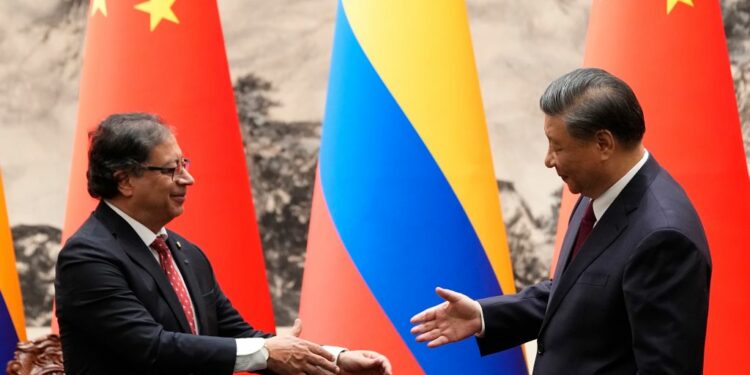China’s Focus on Latin AmericaÂ
China’s intentions in the region are clear – it seeks to increase its influence in Latin America in the geopolitical, diplomatic, and economic spheres. Compared to U.S. presidents who have made nine trips to Latin America in the past 12 years, President Xi has visited 13 of its countries in the same period. One of China’s priorities has been to isolate Taiwan and counter U.S. influence in the Indo-Pacific. As of 2023, seven of the thirteen governments maintaining relations with Taiwan were located in Latin America and the Caribbean, though that number has been steadily dropping. El Salvador cut ties with Taiwan in 2018, followed by Nicaragua in 2021, and Honduras in 2023.Â
China also plays a major role in the region in terms of trade. China is the largest trading partner for Brazil, Chile, Peru, and Uruguay, and ranks second for several other countries. Over the past two decades, trade between China and Latin America has surged from around $18 billion in 2002 to over $500 billion in 2022. By 2024, 21 of the 33 countries in Latin America and the Caribbean had joined the Belt and Road Initiative (BRI), also known as the New Silk Road initiative. Through this program, China has aimed to establish new trade routes and strengthen the interdependence of member nations on its economy.
Over the last decade, China has also increased financing to the region. The largest recipients of Chinese financing in descending order in Latin America are Venezuela, Brazil, Ecuador, and Argentina. China is a donor member of the Inter-American Development Bank, holds observer status at the Organization of American States (OAS), and actively participates in the Community of Latin American and Caribbean States (CELAC) which the U.S. and Canada are not party to.
Overall, Latin American countries have preferred not to choose between China and the U.S., but they have sought to diversify their economies and secure loans with fewer environmental and other conditions imposed by the U.S.
China claims it will not interfere with governance, internal issues, or sovereignty, leading some leaders in the region to welcome this lack of scrutiny. Consequently, it collaborates with the regimes in Venezuela and Cuba, left-leaning governments like Brazil and Colombia, right-leaning Argentina and El Salvador, and everything in between. The primary interest of the Chinese Communist Party is to secure raw materials, strategic minerals, agricultural products, and expand markets for its technologies in the region. It also seeks to maintain power, which requires high rates of economic growth to pursue its goal of creating a “Chinese dream” centered on middle-class security and to support its territorial claims within its perimeter.
Colombia’s Shift Towards China
Efforts to increase collaboration between China and Colombia have been underway in recent years. In October 2023, President Petro visited Beijing to strengthen ties. During his visit, he formalized a strategic partnership that included 12 cooperation instruments, or protocols, to increase Colombian exports to China, including beef and quinoa. Commitments were made in the scientific, technological, and green energy sectors. Colombia has since committed to supporting China’s One-China principle, recognizing Taiwan as part of China.
On January 26, President Petro refused to accept a U.S. military plane carrying Colombian nationals and publicly denounced the use of “inhumane treatment” against the returned migrants. This led to a rapid escalation of tensions, with the Trump administration threatening on X tariffs on Colombia and halting visa processing in the U.S. Embassy, while Petro threatened retaliation tariffs. In the end, Colombia agreed to receive deportation flights and the trade war was avoided.
Following this very public conflict, Trump’s tactics may be pushing Colombia further away from the U.S. We already saw during Trump’s first term, how his confrontational approach pushed other Latin American countries like Peru closer to China. During that time, Panama, El Salvador, and the Dominican Republic turned away from Taiwan and recognized the One China principle.Â
The executive order suspending U.S. foreign assistance drew further disapproval from Colombia. Sources in Colombia who’ve talked to WOLA on the condition of anonymity hold a different view. They state that the aid suspension is devastating to independent media that covers corruption and illegal armed groups’ activities, and to civil society organizations working on peace, human rights, justice and environmental conservation. Lifesaving protection support for social leaders, in the country that ranks top in the world for killings of social leaders, environmental and land defenders, is on hold. Particularly impacted are Afro Descendants, Indigenous, women, youth at risk of recruitment by illegal actors in rural areas affected by internal armed conflict, and urban communities where criminal groups dominate. It is already impacting millions, especially migrants and host communities, which rely on U.S. funded migration integration and humanitarian efforts. Â
Colombia is the U.S.’s main ally in South America regarding trade and cooperation on migration, counter-narcotics, and security. U.S. support for Colombia is crucial for peace, justice, economic development, and tackling the humanitarian and migration crises. If there are more confrontations and U.S. assistance continues to be frozen or is canceled, the U.S. will lose influence in Colombia, leading it directly into the open arms of China.Â
While China is not likely to fill the hole that the suspension of USAID cooperation in Colombia, it is attractive for infrastructure and other economic development projects. The February 6, 2025 opening of a maritime commercial route between Buenaventura (Colombia’s largest port and the most significant for U.S.-Colombia commerce) and Shanghai and the move towards joining the BRI, are just the first steps.Â
Source link : http://www.bing.com/news/apiclick.aspx?ref=FexRss&aid=&tid=67b50f9a165f41d3a5f5c330e2e87758&url=https%3A%2F%2Fwww.wola.org%2Fanalysis%2Fu-s-pushes-its-historic-south-american-ally-towards-china%2F&c=8809890187160703402&mkt=en-us
Author :
Publish date : 2025-02-18 08:54:00
Copyright for syndicated content belongs to the linked Source.












